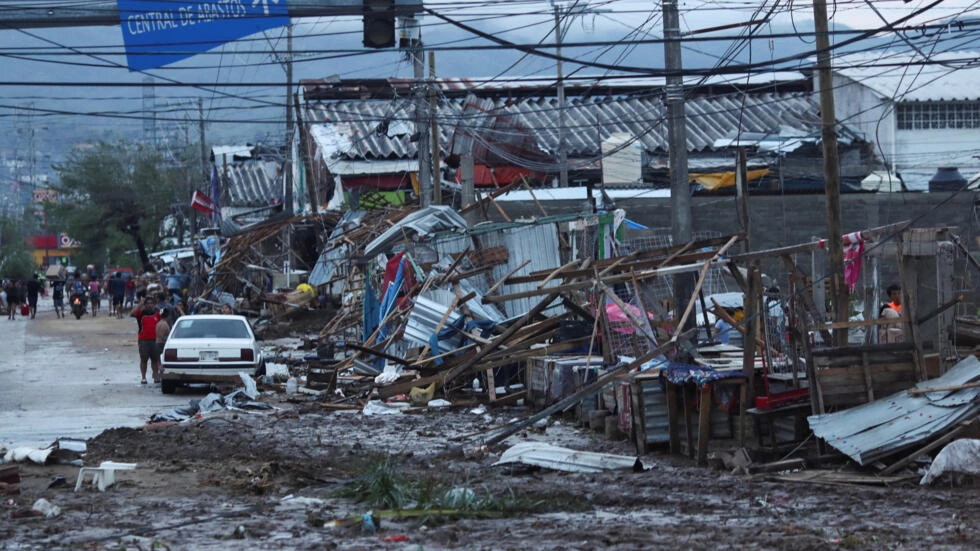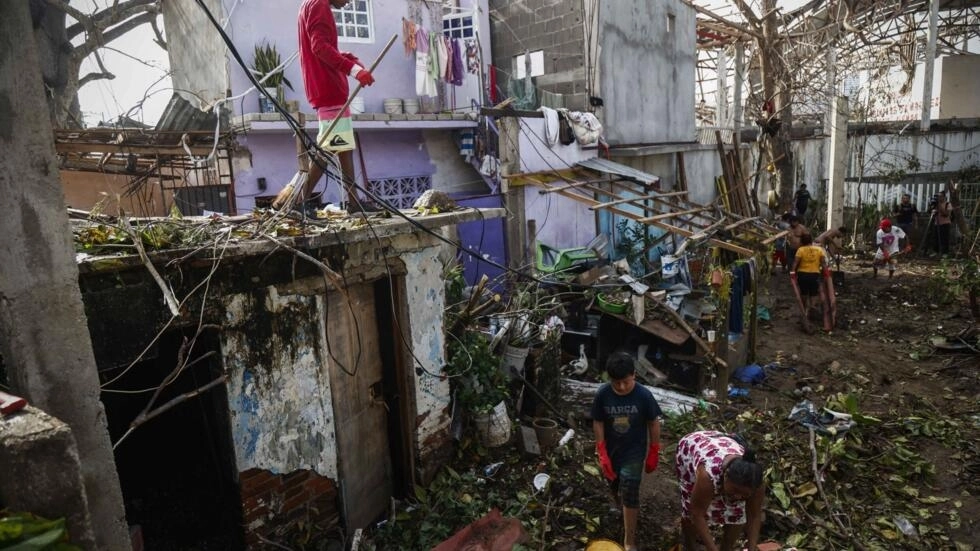This article is more than
1 year oldMexico rushes aid to battered Acapulco in wake of Category 5 Hurricane Otis

President Andres Manuel Lopez Obrador arrived in the seaside city late Wednesday, after his convoy found roads blocked by landslides and other debris, forcing the president and others to abandon their vehicles and walk the final miles.
"The army is bringing machinery and we're going to try to reopen (the highway) as soon as possible," he told journalists who were also trying to reach Acapulco.
He had said earlier that there were no initial reports of deaths but "there's material damage and blocked roads."
The closures forced some to slog for hours through mud and debris in an attempt to find food and shelter.
"Acapulco is a total disaster. It is not what it was before. The park was totally destroyed, the buildings, all the streets," said 24-year-old resident Eric Hernandez, who made the decision to leave on foot.
"The shops had all been looted, people were fighting for things. So we decided to walk as there wasn't anything left there," he said.
Others said an overflowing river and collapsed bridges had cut off communities near Acapulco.
"A lot of people got stuck on the other side of the river in our village, which was overflowing a lot. People were left homeless, there's no electricity," said Israel Perez, a 21-year-old baker.
Aid convoy
A convoy carrying humanitarian aid set off to try to reach Acapulco -- home to about 780,000 people -- by land since the airport was closed, authorities said.
"The urgent thing is to attend to the affected population. We still don't have the damage assessment because there's no communication," Civil Protection national coordinator Laura Velazquez said.
Otis was packing maximum sustained winds of 165 miles (265 kilometers) per hour when it hit the coast, but later dissipated over southern Mexico, the US National Hurricane Center (NHC) said.
The storm had rapidly strengthened to the most powerful category of the five-step Saffir-Simpson scale as it neared land, taking authorities by surprise.
"Rarely, according to records, does a hurricane develop so quickly and with such force," Lopez Obrador said.
People recounted a terrifying ordeal as Otis made landfall overnight on the usually sun-kissed resort town.
"The building shook as if there was an earthquake," Citlali Portillo, a tourist accommodation manager, told the television channel Televisa, adding that she had taken shelter in a bathtub.
Tourists hunker down
Videos posted on social media showed severely damaged hotels and other buildings, including many shattered windows.
Tourists used beds and mattresses for protection in their hotel rooms, once windows were blown out.
"We protected ourselves with barricades made by children, women, men... many were injured by glass," said Nely Palacios, a Mexican tourist.
Toppled trees were seen in the debris-strewn streets and a shopping mall appeared to have suffered major structural damage in Acapulco, located in the southern state of Guerrero.
More than 500 emergency shelters were opened for residents.
There were widespread power blackouts, though state electricity company CFE said Wednesday that it had managed to restore supply to 40 percent of the more than half a million affected customers.
Heavy rains continued to deluge Guerrero and parts of neighboring Oaxaca -- two of Mexico's poorest states, home to remote mountain communities.
"This rainfall will produce flash and urban flooding, along with mudslides in areas of higher terrain," the NHC warned.
Frequent storms
Hurricanes hit Mexico every year on both its Pacific and Atlantic coasts, usually between May and November, though few make landfall as a Category 5.
In October 1997, Hurricane Pauline hit Mexico's Pacific coast as a Category 4 storm, leaving more than 200 people dead, some of them in Acapulco.
It was one of the deadliest hurricanes to batter Mexico.
In October 2015, Patricia became the most powerful hurricane ever recorded, pummeling Mexico's Pacific coast with sustained winds of 200 miles per hour.
But the storm caused only material damage and no deaths as it made landfall in a sparsely populated mountainous area.
Just this week, Tropical Storm Norma left three people dead, including a child, after making landfall for a second time in the northwestern state of Sinaloa.
Earlier this month, two people died when Category 4 Hurricane Lidia struck the western states of Jalisco and Nayarit.
Scientists have warned that storms are becoming more powerful as the world gets warmer with climate change.
(AFP)
Keywords
Newer articles
<p>A bill that will ban TikTok in the United States unless its Chinese owner divests from the company has passed overwhelmingly.</p>
Congress gets closer to forcing TikTok to be sold or face US ban: What's ne
Israel Iran attack: Damage seen at air base in Isfahan
Ukraine ‘will have a chance at victory’ with new US aid, Zelenskyy says
Ukraine war: Kyiv uses longer-range US missiles for first time
Who will be Trump’s VP? A shortlist
Congress passes bill that could ban TikTok after years of false starts
House passes potential TikTok ban that could speed through Senate
How soon could US ban TikTok after Congress approved bill?
Finally, America’s Congress does right by Ukraine




